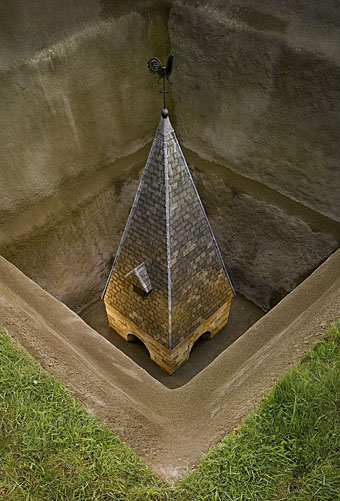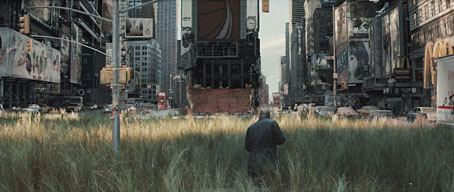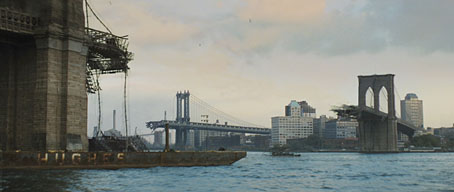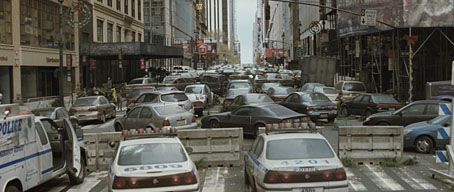Archaeological Site (A Sorry-Installation) by Guillaume Bijl.
A work for the Skulptur Projekte Münster 07. More views on Flickr.
Category: {architecture}
Architecture
The temples of Angkor
The Temple of Bakong (2001).
The temples and ruins of Angkor Wat and Angkor Thom are effortlessly photogenic, so much so it seems impossible to take a bad picture of them. John McDermott’s photographs are especially fine, not least because he’s used infra-red film which always gives foliage a peculiar luminous appearance. Simon Marsden is the big populariser of this technique with his many photographs of ruins in Britain and Ireland.
Previously on { feuilleton }
• Adolph Sutro’s Gingerbread Palace
• The Jantar Mantar
• Hungarian water towers
• Karel Plicka’s views of Prague
• Atget’s Paris
New York City abandoned
That great staple of science fiction and horror stories—the derelict city—turns up again in the trailer for the latest adaptation of Richard Matheson’s pulp classic, I Am Legend. The novel has an obvious appeal for filmmakers since Matheson was an accomplished screenwriter and an expert at crafting taught, high concept storylines. Other notable productions of his work include The Incredible Shrinking Man (one of JG Ballard’s favourite films; currently being remade), British horror thriller Night of the Eagle, Roger Corman’s Poe adaptations, the Night Stalker/Night Strangler TV movies, Steven Spielberg’s early film, Duel, and one of the most memorable episodes of The Twilight Zone, ‘Nightmare at 20,000 feet‘.

First edition jacket (1954).
The premise of I Am Legend is simple and direct: what would it be like to be the last man on earth if vampires (actually plague victims with vampire-like symptoms) had taken over the world? The book was first filmed in 1964 as The Last Man on Earth starring Vincent Price. I’ve never seen this but due to one of those copyright quirks it’s now in the public domain and can be downloaded for free here. George Romero’s 1968 Night of the Living Dead (and his subsequent zombie saga) was influenced by Matheson’s novel, then a big budget version arrived in 1972, The Omega Man, with Charlton Heston in typical gung-ho mode. I was impressed with that when I saw it as a teenager but it now seems fatuous for the most part. The new film has Will Smith as Matheson’s lone survivor in a setting that greatly benefits from judicious use of CGI to roughen the views of the abandoned city (especially good in the HD trailer). I’ve no idea yet how this will fare as an adaptation. Matheson’s novel ends on a bleak note that a director like Romero would have no problem with but which Hollywood hates so I’m inclined to be suspicious; The Omega Man changed the tone and the ending of the book substantially. The film is released in December, so we’ll find out then.
Previously on { feuilleton }
• Nosferatu
Ginsberg’s Howl and the view from the street
 James Campbell in The Guardian this weekend writes about the arrest fifty years ago of Lawrence Ferlinghetti for his publishing Allen Ginsberg’s paean to ecstatic drug use and gay sex, Howl and Other Poems. Ferlinghetti was arrested on charges of selling (or “peddling”, as these prissy turns of phrase always have it) literature likely to be harmful to minors, even though it’s hard to imagine there were gangs of schoolkids rushing into his City Lights bookstore to buy a volume of experimental poetry. The ensuing trial was the first in a series of cases in the late Fifties and early Sixties which finally established (in America, at least) that the law needed to try and keep its hands off literary works.
James Campbell in The Guardian this weekend writes about the arrest fifty years ago of Lawrence Ferlinghetti for his publishing Allen Ginsberg’s paean to ecstatic drug use and gay sex, Howl and Other Poems. Ferlinghetti was arrested on charges of selling (or “peddling”, as these prissy turns of phrase always have it) literature likely to be harmful to minors, even though it’s hard to imagine there were gangs of schoolkids rushing into his City Lights bookstore to buy a volume of experimental poetry. The ensuing trial was the first in a series of cases in the late Fifties and early Sixties which finally established (in America, at least) that the law needed to try and keep its hands off literary works.
America since 1957 has managed to grow up on one level, with Howl now regarded as a classic work of 20th century poetry, and grow more infantile on the other, with And Tango Makes Three, a childrens’ book about gay penguins, being the most-challenged book of 2006 according to the America Library Association; you can still rely on the “g” word to get the would-be book-burners agitated. The growing gulf between perceptions of morality in the US versus those in Europe can be seen in the way that US librarians need to hold an annual Banned Books Week to draw attention to the ongoing war between prudery and licence while there’s no equivalent to this in the UK. Britons used to look enviously at America’s freedoms of speech but the atmosphere has relaxed considerably here over the past twenty years while in America it sometimes seems that the clock is running backwards. That said, Russ Kick pointed out several years ago how, even among freedom-loving librarians, some books are more defensible than others.
The City Lights bookstore is located at 261 Columbus Avenue, San Francisco, and by coincidence I’ve spent the past couple of days exploring that locale using Google’s remarkable Street View facility which is now a feature on their San Francisco map, together with those for New York, Miami, Las Vegas and Denver. Not all the streets in these cities have been photographed yet but it’s fascinating to not only see places you’ve already been to but then turn down a side street and see the places you missed. If you want to know what it’s like to drive across the Golden Gate Bridge then here’s your chance.
Continue reading “Ginsberg’s Howl and the view from the street”
Postopolis: Art and Architecture
Postopolis: Art and Architecture
Event details and live blog at City of Sound.






